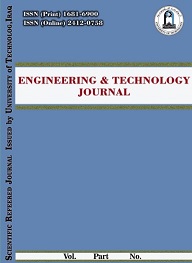Abstract
A numerical study was carried out to predict the behavior of complex flow
and forced convection heat transfer characteristics in a duct with two right– angled
bends for both laminar and turbulent flows. The finite differences method was
employed to solve the Navier – Stokes and energy equations. The thermal
boundary conditions at the duct walls are adopted by using an isothermal for
laminar flow and transient heat conducted with convection for turbulent flow. The
equations of vorticity and energy have been solved by using the explicit method.
The computations were performed for step height ratios (H/W=2, 3, and 4), inlet
air velocities (0.12-1.0 m/s) for Reynolds number (568-33334), ambient air
temperature of (30-35˚C), duct wall thickness of (0.002-0.004 m) and different
duct metal on the behavior of the flow and heat transfer. Generally, the effect of
the step ratio on the bulk temperature and local heat transfer is minor for H/W
equal or greater than 3. Also, it is found that both flow and heat transfer patterns
change drastically from laminar to turbulent flows. Moreover, in the turbulent flow
regime, the maximum heat transfer rates occur at increasing of the inlet air velocity
and the ambient air temperature, also at decrease in the duct width and wall
thickness with aluminum duct. Also, it was found that the bulk temperature tends
to reach a higher value at the duct bends (separation and recirculation regions) and
lower values for the local Nusselt number. The numerical results of local Nusselt
number along the duct wall for laminar flow were compared with published
experiment results. The comparison indicates reasonable agreement
and forced convection heat transfer characteristics in a duct with two right– angled
bends for both laminar and turbulent flows. The finite differences method was
employed to solve the Navier – Stokes and energy equations. The thermal
boundary conditions at the duct walls are adopted by using an isothermal for
laminar flow and transient heat conducted with convection for turbulent flow. The
equations of vorticity and energy have been solved by using the explicit method.
The computations were performed for step height ratios (H/W=2, 3, and 4), inlet
air velocities (0.12-1.0 m/s) for Reynolds number (568-33334), ambient air
temperature of (30-35˚C), duct wall thickness of (0.002-0.004 m) and different
duct metal on the behavior of the flow and heat transfer. Generally, the effect of
the step ratio on the bulk temperature and local heat transfer is minor for H/W
equal or greater than 3. Also, it is found that both flow and heat transfer patterns
change drastically from laminar to turbulent flows. Moreover, in the turbulent flow
regime, the maximum heat transfer rates occur at increasing of the inlet air velocity
and the ambient air temperature, also at decrease in the duct width and wall
thickness with aluminum duct. Also, it was found that the bulk temperature tends
to reach a higher value at the duct bends (separation and recirculation regions) and
lower values for the local Nusselt number. The numerical results of local Nusselt
number along the duct wall for laminar flow were compared with published
experiment results. The comparison indicates reasonable agreement
